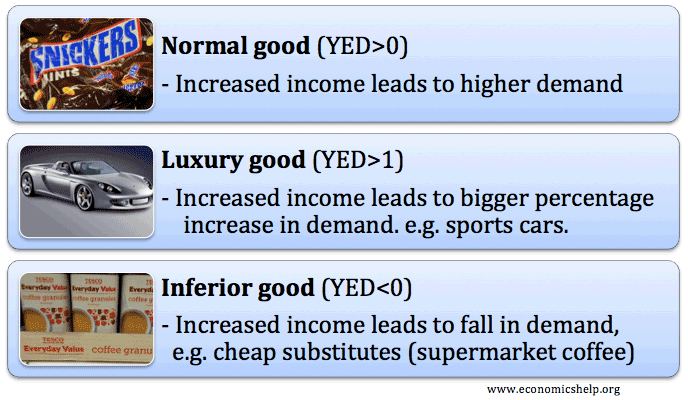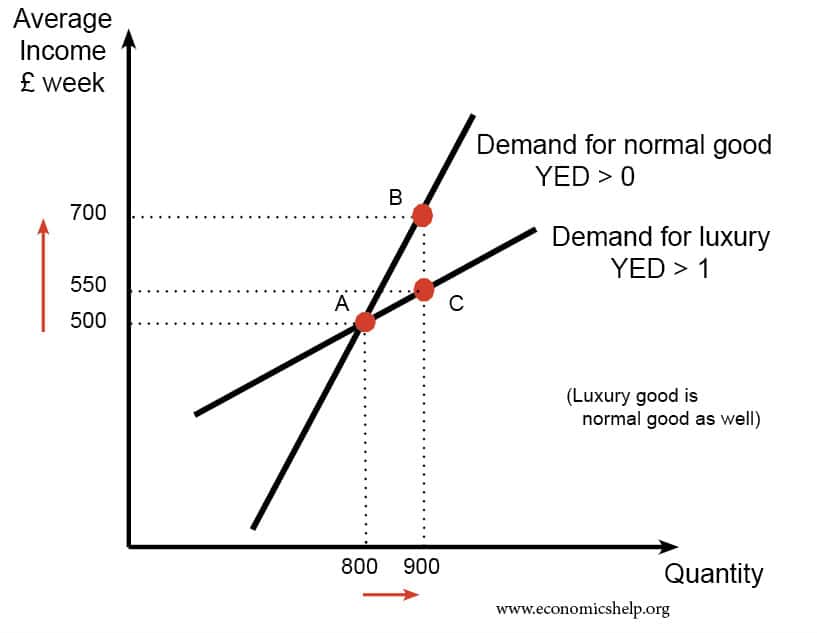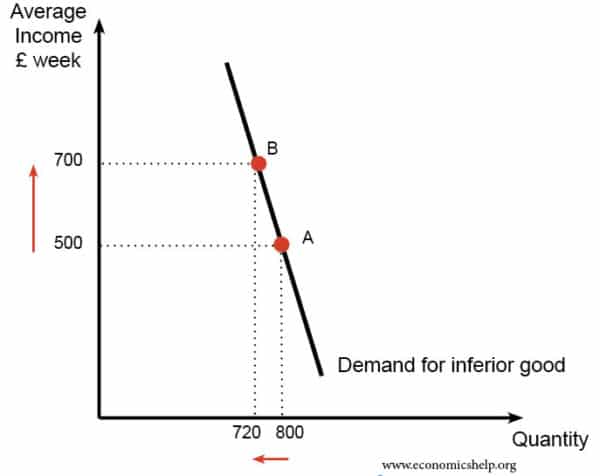A list of different types of economic goods.
Income elasticity of demand and types of goods
Income elasticity of demand (YED) measures the responsiveness of demand to a change in income.
Normal good
- A normal good means an increase in income causes an increase in demand. It has a positive income elasticity of demand YED. Note a normal good can be income elastic or income inelastic.
Luxury good
A luxury good means an increase in income causes a bigger percentage increase in demand. It means that the income elasticity of demand is greater than one. For example, HD TV’s would be a luxury good. When income rises, people spend a higher percentage of their income on the luxury good.
YED calculations
- In the above example of a luxury good, income rises (500-550) 10%, demand rises 100/800 – 12.5% YED = 12.5/10 = 1.125
- In the above example of a normal good, income rises (500-700) 40%, demand rises 100/800 – 12.5% YED – 12.5/40 = 0.3125
Note: a luxury good is also a normal good, but a normal good isn’t necessarily a luxury good.
Inferior good
An inferior good means an increase in income causes a fall in demand. It is a good with a negative income elasticity of demand (YED). An example of an inferior good is Tesco value bread. When your income rises you buy less Tesco value bread and more high quality, organic bread.
Examples of different types of good
- Luxury good – Superfast broadband, organic luxury coffee, Netflix tv, Porsche, a foreign holiday to Bali
- Normal good – ordinary broadband, ordinary tv license, Ford Focus car, holiday to somewhere close to where you live
- Inferior good – Supermarket own brand coffee, bus travel, a day out at theme park.
Other types of goods
- Necessity good – something needed for basic human existence, e.g. food, water, housing, electricity. Though this becomes a subjective term, is electricity a necessity? Is broadband internet a necessity?
- Comfort good – a good which isn’t a necessity, but gives enjoyment/utility, e.g. subscription to netflix or take-away food. A comfort good may become a luxury.
- Complementary Goods. Goods which are used together, e.g. TV and DVD player. see: Complementary goods
- Substitute goods. Goods which are alternatives, e.g. Pepsi and Coca-cola. See Substitute goods.
- Giffen good. A rare type of good, where an increase in price causes an increase in demand. The reason is that the income effect of a rise in the price causes you to buy more of this cheap good because you can’t afford more expensive goods. For example, if the price of wheat rises, a poor peasant may not be able to afford meat anymore, so has to buy more wheat. See: Giffen goods
- Possible examples of Giffen good – rice, potatoes, bread.
- Veblen / Snob good. A good where an increase in price encourages people to buy more of it. This is because they think more expensive goods are better. See: Veblen good
- Example of Veblen / Snob good – some forms of art, designer clothes.
Market Failure
- Public goods – goods with characteristics of non-rivalry and non-excludability, e.g. national defence. See: Public Goods
- Quasi-public good – goods which have some of the characteristics of non-rivalry and non-excludability, but not 100%. For example, interest is mostly very cheap to access. Once provided, you can access most website – though some websites may charge to view (e.g. newspapers).
- Merit goods. Goods which people may underestimate benefits of. Also often has positive externalities, e.g. education. See: Merit goods
- Demerit goods. Goods where people may underestimate the costs of consuming it. Often has negative externalities, e.g. smoking, drugs. See: Demerit goods
- Private goods – goods which do have rivalry and excludability. The opposite of a public good See: private goods
- Free goods – A good with no opportunity cost, e.g. breathing air. See: Free good
Related




What are the definitions for Giffen,Bads and Complement Goods?
what are the effects elasticity on consumer goods and capital gods giving examples of the consumer and the capital goods?
where is others types
Speculative demand – potential buyers are interested not just in the satisfaction they may get from consuming the product, but also the potential rise in market price leading to a capital gain or profit
Giffen Goods – special type of inferior good may exist, which disobeys the “law of demand”. When the price of a Giffen Good decreases, the demand for that good decreases. This would have to be a good that is such a large proportion of a person or market’s consumption that the income effect of a price increase would produce, effectively, more demand. The observed demand curve would slope upward, indicating positive elasticity.
Complementary goods – are said to be in joint demand e.g. fish and chips, DVD players and DVDs, iron ore and steel. People generally purchase both goods together therefore a rise in the price of a complement to Good X should cause a fall in the demand for X and therefore good Y- A change in the demand for these goods will directly affect the demand for their complementary goods.
The extent to which a change in the price of one good leads to a change in the demand for a complement is determined by the cross-price elasticity of demand.
most people like me for instance…tend to find a problem on how other countries have a good economic growth while others stragle alot. i believed that the course of that is when a country exports more than it imports. Argumentatively, is well known fact that all the resources are scarce but what accually is scarce about them regardless of the nature because is never enough for humans. is it possible for all the countries to have the stable economic growth to monotor and innovate a common currency hance poverty reduced???????
how to study economics for exams it is very diffucult for me to understand the topics what my teachers teach becaue she teaches too fast and finishes one topic in one class and will not explain the important points at all can you please help me out to study for the exam point of view sir please.
the roles played by money in an economy?
what are the roles played by money in an economy?
Explain different type of goods and its behavior according to the change of elasticity..
Manufacturing
Manufacturing is the use of machines, tools and labor to make things for use or sale. The term may refer to a range of human activity, from handicraft to high tech, but is most commonly applied to industrial production, in which raw materials are transformed into finished goods on a large scale. Such finished goods may be used for manufacturing other, more complex products, such as household appliances or automobiles, or sold to wholesalers, who in turn sell them to retailers, who then sell them to end users – the “consumers”.
Manufacturing takes turns under all types of economic systems. In a free market economy, manufacturing is usually directed toward the mass production of products for sale to consumers at a profit. In a collectivist economy, manufacturing is more frequently directed by the state to supply a centrally planned economy. In free market economies, manufacturing occurs under some degree of government regulation.
Modern manufacturing includes all intermediate processes required for the production and integration of a product’s components. Some industries, such as semiconductor and steel manufacturers use the term fabrication instead.
The manufacturing sector is closely connected with engineering and industrial design. Examples of major manufacturers in the United States include General Motors Corporation, Ford Motor Company, Chrysler, Boeing, Gates Corporation and Pfizer. Examples in Europe include Airbus, Daimler, BMW, Fiat, and Michelin Tyre.
Types of Goods
Definition Inferior Good: An inferior good means an increase in income causes a fall in demand. It has a negative YED. An example, of an inferior good is Tesco value bread. When your income rises you buy less Tesco value bread and more high quality, organic bread.
Definition Normal Good- This means an increase in income causes an increase in demand. It has a positive YED. Note a normal good can be income elastic or income inelastic.
Definition Luxury Good-A luxury good means an increase in income causes a bigger % increase in demand. It means that the YED is greater than one. For example, high Definition TV’s would be luxury. When income rises, people spend a higher % of their income on the luxury good.
i really wanted know more about private,public,free and merit goods not luxury,normal and inferior goods.that makes absolutley no sence at all. well by the thnx for ur answer.
Is there any difference in this question ” Enumerate and define types of goods sold in a store.” ?
Me too having same problem. In 5 seminars we have to completed one book with assignments. Thats crazy. Economics…uwakssss…..yaksss….I dont know wat is DD, SS, Cost structures……devada……
more details about these types of goods